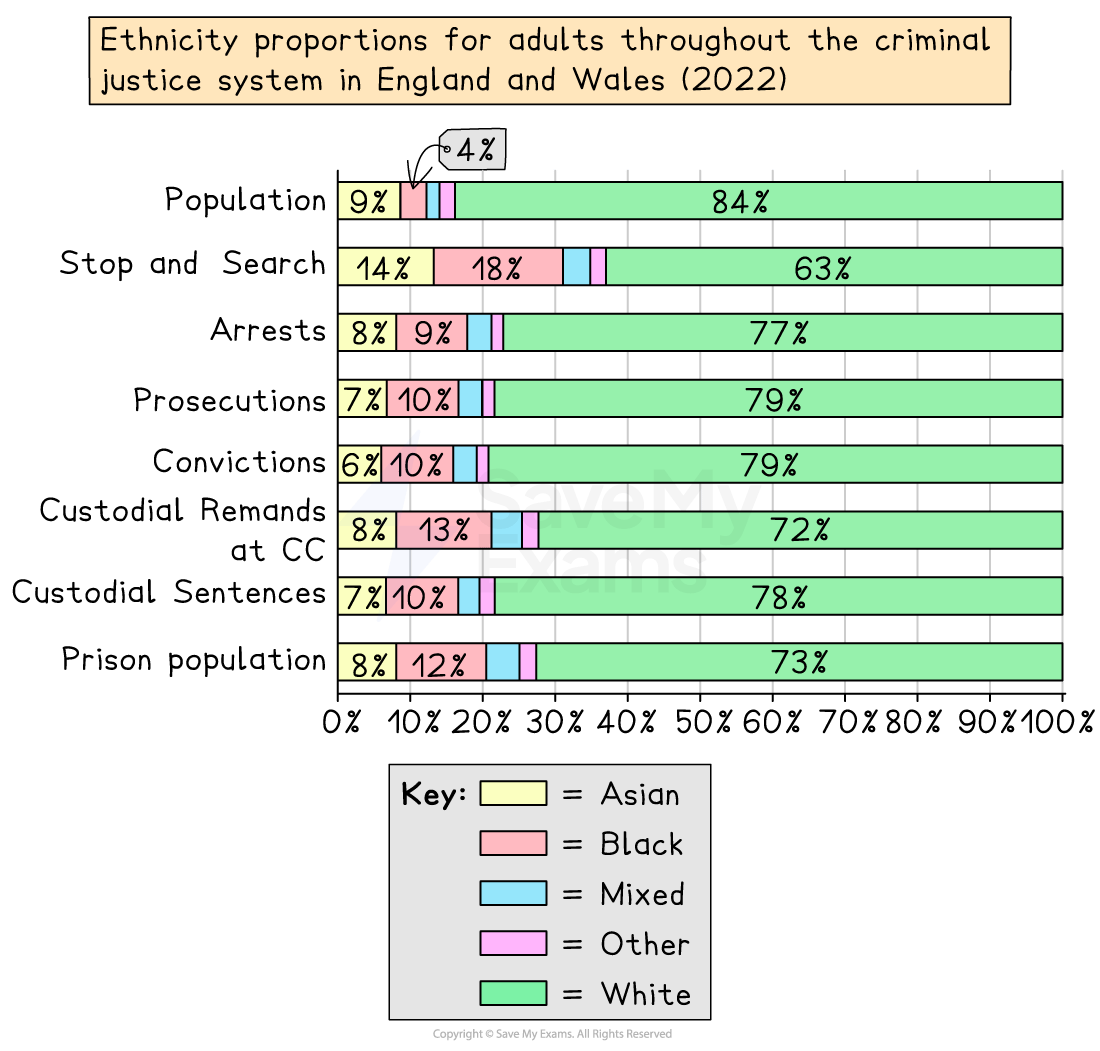Ethnicity & Criminal Behaviour (AQA A Level Sociology): Revision Note
Exam code: 7192
Statistics on ethnicity & crime
Some minority ethnic groups are over-represented at key stages of the Criminal Justice System (CJS) compared with their share of the population
This pattern is most visible in stop & search, arrests, custodial remand, and the prison population (Ministry of Justice, 2024)
Victim data from the CSEW shows variation by ethnicity
People with mixed ethnicity report higher victimisation than average
Arrests
In 2022/23, black people were 2.2× as likely to be arrested as white people
20.4 vs 9.4 per 1,000 (Ethnicity facts and figures, GOV.UK, 2024)
Stop and search
Year ending March 2023, Black people were over 4x as likely to be stopped and searched as White people (Ethnicity facts and figures, GOV.UK, 2024)
24.5 stop & searches per 1,000 black people
5.9 stop & searches per 1,000 white people
Sentencing
Black prisoners served a greater share of their original determinate sentence in custody (68%) than white (59%) or Asian (58%) prisoners in 2022 (Ministry of Justice, 2024)
Prison
On 30 Jun 2023, prisoners (where ethnicity known) were majority white (Ministry of Justice, 2024)
73% white
27% ethnic minority groups (12% Black, 8% Asian, 5% Mixed, 2% Other)
On 31 Mar 2023, black prisoners were 14% of the remand population and 12% of the sentenced population (HMPPS Offender Equalities Annual Report 2022–23)
These trends suggest a combination of both structural inequality (over-policing, harsher sentencing) and social disadvantage may explain the disparities

Ethnicity, racism and the Criminal Justice System (CJS)
There are significant ethnic differences at every stage of the criminal justice process
Research highlights both institutional discrimination and social factors that shape these patterns
Policing
Since the 1970s, the police have faced accusations of institutional racism (Phillips & Bowling, 2012)
Black and Asian groups are more likely to be over-policed and subjected to stop and search
Stop and search
Police are more likely to stop and search Black and Asian individuals, especially under Section 60 (public order) and the Terrorism Act 2000
Under the Terrorism Act, Asian people are more likely than others to be stopped
Black people are 7× more likely to be stopped than white people
Only a small proportion of stop and searches result in arrest
Minority groups are less likely to believe stops are based on 'reasonable suspicion'
Phillips & Bowling (2007) argue that minorities often feel 'over-policed and under-protected', leading to limited trust in the police
Tasers
Hoyle (2015) found that the use of tasers was 6 in 10,000 for white people vs 18 in 10,000 for black people
The IOPC review of 101 taser cases from 2015-20 found that 60% of Black people tasered endured discharges over 5 seconds vs 29% of White people (The Guardian, 2021) (opens in a new tab)
Prosecution, trial, & sentencing
The processes of prosecution, trial, and sentencing reveal clear patterns of inequality in how different ethnic groups are treated within the criminal justice system
Research shows that Black and Asian individuals often face disadvantages at multiple stages, from arrest and cautioning through to imprisonment
These disparities are linked to factors such as:
mistrust of the police
decisions made by the Crown Prosecution Service (CPS)
stereotypes influencing sentencing
Arrests and cautions
Black and Asian people are less likely to receive a caution, making them more likely to face court
One reason is a higher likelihood of denying the offence and requesting legal advice, often due to mistrust of the police
Prosecution and trial
The CPS is more likely to drop cases against minority defendants, suggesting weaker evidence or police bias (Phillips & Bowling, 2002)
Minority ethnic defendants show less trust in magistrates, often opting for trial by jury at the Crown Court
But Crown Court convictions carry the risk of harsher sentences
Convictions and sentencing
Black and Asian defendants are less likely to be found guilty than white defendants
This may reflect weak or unfounded cases being pursued
Black offenders have imprisonment rates 3% higher than white offenders
This may be due to differences in the seriousness of the offences or due to defendants' previous convictions
Asian offenders are more likely to receive longer custodial sentences
Pre-sentence reports (PSRs)
PSRs, written by probation officers, influence Magistrates' sentencing decisions
They can reinforce stereotypes (Hudson & Bramhall, 2005)
Black offenders tend to be viewed as higher risk
Asian offenders are seen as less remorseful
Prison
Black offenders are
more likely to be in custody
less likely to be granted bail
more likely to serve longer sentences
Similar ethnic patterns exist in the USA
Explaining the patterns
Institutional racism (The Macpherson Report, 1999)
The Macpherson Report (1999), after the murder of Stephen Lawrence, concluded that the CJS is institutionally racist, from policing to sentencing
Phillips & Bowling (2012) found that many officers hold negative stereotypes of ethnic minorities as 'criminals', leading to deliberate targeting for stop and search
Ethnic differences in offending
Some argue disproportionality reflects real differences in offending
Low-discretion stops are based on intelligence (e.g., offender description)
High-discretion stops are based on officer judgement, where bias and stereotypes can drive disproportionality
Demographic explanations
Ethnic minority groups in the UK have a higher proportion of
young people
urban dwellers
unemployed individuals
These groups are statistically more likely to be stopped regardless of ethnicity
Since minorities are over-represented in these categories, they appear more likely to offend, creating the illusion of higher offending rates

Unlock more, it's free!
Did this page help you?